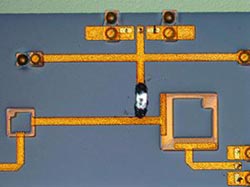A step up in wavelength

The system-on-package component for converting millimeter waves operates at the highest frequency of any device of its type. <br>Copyright : © 2013 A*STAR Institute of Microelectronics <br>
Millimeter waves are a type of radiofrequency electromagnetic radiation with wavelengths between 0.1 and 10 millimeters long. Because they are susceptible to absorption by water in the atmosphere, they travel short distances only.
Despite this limitation, their short wavelength makes them a useful technology for small-distance applications. Examples include short-range, secure wireless communication and automotive-radar technology, which lets self-driving cars sense their environment.
Electronic components that can manipulate millimeter waves are vital for realizing this potential in commercial applications. Specifically, it is important to change the wavelength of such waves from, for example, one that is optimal for sending information across short distances to one that is more easily processed electronically.
Rui Li and co©workers at the A*STAR Institute of Microelectronics, Singapore, have designed and fabricated an electronic module that can convert a millimeter wave from one wavelength to another. The device, called a subharmonic passive mixer (see image), mixes an incoming millimeter wave that has a wavelength of 2.2 millimeters with a local source of 4.3-millimeter waves to generate a 1.1-millimeter signal. A signal of this wavelength means that the device operates at a frequency of 273 gigahertz; that is, 273 billion oscillations per second. Operation at such a high frequency allows a large number of potential transmission channels.
Importantly, the researchers¡¯ device is based on a technology called ¡®system-on-package¡¯, where the components are attached to a package. ¡°It is the first time that [an on-package] converter has operated at such a high frequency,¡± says Li. In contrast, conventional electronic devices, such as laptops and phones, are miniaturized by combining hundreds of electrical devices on a silicon chip. This approach becomes problematic when dealing with electronic components that operate at radiofrequencies. The low electrical resistivity of silicon results in an energy loss that degrades the overall system performance. The manufacturing cost is also high because the components occupy a large area.
The device developed by Li and her co-workers comprised three stacked thin films of metal, and the choice of material to separate these layers was crucial to it¡¯s efficient operation. The researchers used benzocyclobutene ¡ª a polymer that, unlike silicon, is known to have good electrical performance, even in the millimeter-wave region. Thorough electrical testing confirmed the high-performance of their design.
¡°We are currently in the process of designing and implementing numerous similar types of millimeter-wave passive components in various types of package,¡± says Li. ¡°We hope this will reduce the chip area as compared to ¡®on-chip¡¯-based approaches.¡±
The A*STAR-affiliated researchers contributing to this research are from the Institute of Microelectronics
Associated links
Li, R., Lim, T. G. & Ho, S. W. 273-GHz 2X subharmonic up-conversion mixer for system-on-package applications. IEEE Transactions on Components, Packaging and Manufacturing Technology 2, 1980¨C1984 (2012)
Media Contact
All latest news from the category: Communications Media
Engineering and research-driven innovations in the field of communications are addressed here, in addition to business developments in the field of media-wide communications.
innovations-report offers informative reports and articles related to interactive media, media management, digital television, E-business, online advertising and information and communications technologies.
Newest articles

Combatting disruptive ‘noise’ in quantum communication
In a significant milestone for quantum communication technology, an experiment has demonstrated how networks can be leveraged to combat disruptive ‘noise’ in quantum communications. The international effort led by researchers…

Stretchable quantum dot display
Intrinsically stretchable quantum dot-based light-emitting diodes achieved record-breaking performance. A team of South Korean scientists led by Professor KIM Dae-Hyeong of the Center for Nanoparticle Research within the Institute for…

Internet can achieve quantum speed with light saved as sound
Researchers at the University of Copenhagen’s Niels Bohr Institute have developed a new way to create quantum memory: A small drum can store data sent with light in its sonic…





















